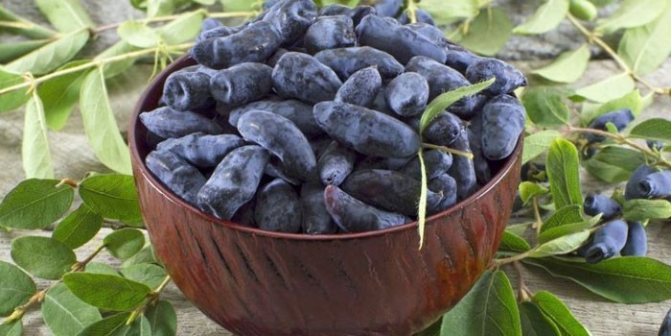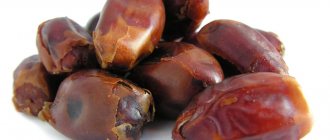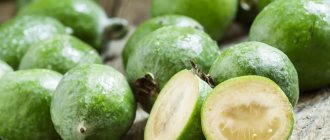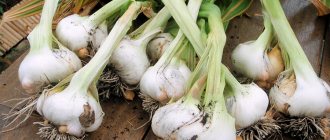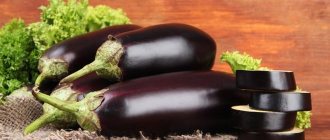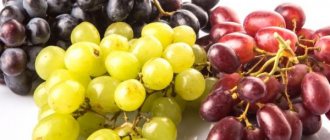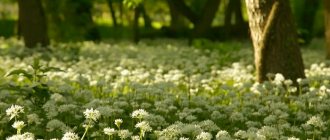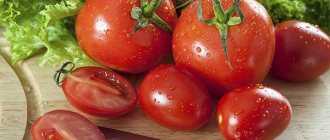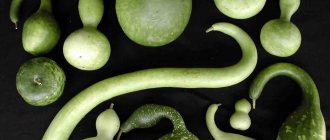Honeysuckle is a shrub that bears fruit of blue and oblong shape. To date, botanists know about 190 varieties of this plant. His homeland is Asia. In our country, there are about 14 varieties, but only 3 of them are suitable for consumption. Most often, shrubs can be found on Sakhalin, Kamchatka and in the territory of Eastern Siberia. The plant perfectly tolerates frosts, up to -50 degrees. Now the shrub can be found in many areas, but the healing properties were found only in the fruits of a dark blue color, shrubs with fruits of a different color have an exclusively decorative function.
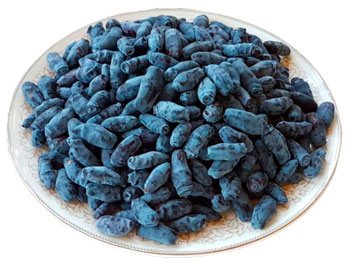
| Calories per 100 g, (kcal): | 30 |
| Protein in 100 g, (g): | 0.0 |
| Fat in 100 g, (g): | 0.0 |
| Carbohydrates per 100 g, (g): | 7.8 |
| Glycemic index: | 20 |
Benefits of honeysuckle, vitamins and minerals
B vitamins help the body to stabilize metabolic processes, improve memory and mental activity. Carotene helps prevent diseases of the organs of vision, and vitamin C has a rejuvenating effect on the body and on the skin as well.
The fruits are high in sodium, which helps to normalize the blood composition and helps the peripheral nervous system to function normally. And in combination with potassium, it helps cells regenerate. Iodine has a good effect on the thyroid gland, and copper, in combination with iron, participates in the synthesis of hemoglobin.
Thanks to silicon and zinc, it improves hair growth and the condition of the skin and nails. Barium helps to strengthen the heart muscle and prevents the development of gastrointestinal diseases. The fruit even contains aluminum, which is responsible for the production of gastric juice.
Chemical composition
As I wrote above, honeysuckle berries contain a lot of vitamin C, and also contain provitamin A, vitamins B1, B2, B9.
In addition, berries contain a large amount of trace elements and minerals:
- potassium
- magnesium
- phosphorus
- silicon
- manganese
- calcium
- zinc
- sodium
- iodine
- selenium
- copper
- aluminum
- iron and others.
Honeysuckle contains:
- organic acids (citric, malic, oxalic, succinic)
- sugars (glucose, fructose, sucrose)
- tanning
- pectin substances.
The benefits of honeysuckle for women
The fruits of the bush are recommended for use during menopause, when mood swings are constantly observed, hot temper is often manifested. They help to cope with stomach upsets and normalize the acidity of the stomach.
Honeysuckle has a choleretic and diuretic effect, removes excess fluid, therefore, prevents edema. The berries are recommended for people who often have nosebleeds, they help to reduce pressure and improve the functioning of the stomach.
During pregnancy and breastfeeding
Honeysuckle preparations during pregnancy help eliminate edema, normalize the work of the heart and blood vessels, and replenish the mother's body with vitamins. To do this, you just need to eat a few fruits before eating, or drink infusions and decoctions when fresh berries are absent.
After the baby is born, eating honeysuckle is allowed only after 3 months. You need to start with a few pieces, observing how the baby's body will react. If he does not have an allergy or disorder, then the dose can be gradually increased.
The benefits of honeysuckle for men
The composition of the fruit contains a unique substance "selenium", which is responsible for the normal functioning of the male genital area and improves sperm production.
With the help of berries, you can quickly recover from surgery or long-term drug treatment.
With regular consumption of the fruits of the bush, men will be able to prevent hair loss. Berries help to improve metabolism. And the pectins contained in berries protect the gastric mucosa from the negative effects of food.
Honeysuckle helps to improve the condition of the liver and is an excellent tonic food product that normalizes blood pressure.
Culinary recipes
The use of honeysuckle in cooking is popular for obtaining safe natural dyes and coloring cakes, creams, desserts with them. The benefits of honeysuckle are perfectly preserved when the berries are frozen and completely passes into the juice extracted from the fruits, fruit drink. The content of pectins allows you to add honeysuckle to jelly, make jelly from it.
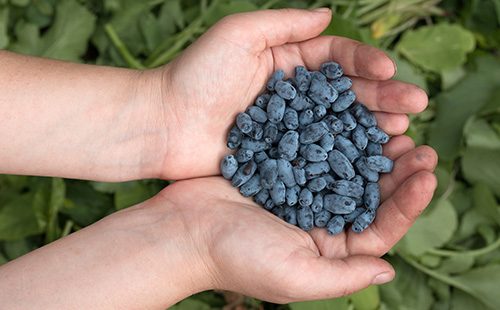

Jam
Features. To make honeysuckle jam, it is better to use selected whole fruits, just ripe, with a sweet and sour taste. From them, the jam is especially tasty.
Preparation
- Syrup is made from a kilogram of sugar.
- While the syrup is hot, prepared (sorted, washed and dried) berries are immersed in it.
- The mixture is brought to a boil, shaking occasionally.
- Boil for several minutes and turn it off.
- After a few hours, repeat boiling, after which the jam is poured into prepared jars.
Wine
Features. Honeysuckle wine takes a long time to prepare, but it surprises with its extraordinary taste and a set of healing properties.
Preparation
- Ripe honeysuckle fruits (2 kg) are crushed in mashed potatoes, which are placed in a wide-necked bowl.
- 350 g of granulated sugar and a couple of liters of water are added to the berries.
- The container is closed with gauze, placed in a dark place at room temperature for a period of four days, during which the mixture should be regularly stirred.
- After that, the mixture is filtered through cheesecloth, squeezed out and the cake is thrown away.
- Add 100 g of granulated sugar to the resulting liquid, mix thoroughly, leave for the next fermentation in a dark, warm place, attaching a rubber glove with a hole in one finger to the neck of the container.
- After six days, a little wort is cast, mixed with 150 g of granulated sugar, the mixture is poured into the main bottle. After a six-day break, the procedure is repeated.
- After two months, the wort is removed from the sediment, poured into bottles for storage, kept for two to six months, regularly checking for sediment and removing the wine from it, if necessary.
The benefits of honeysuckle berries are manifested in different ways. Someone will appreciate her ability to heal the stomach, and someone - aromatic wine made from fruits. Medicines can help cope with disease, and eating fresh, frozen or processed berries will be a great help to good health.
What does honeysuckle treat? How to take it medicinally
For medicinal purposes, all parts of the shrub are used, except for the roots.
Berries are often used after thermal or other culinary processing, for example, in the form of jam or wine, they make compotes or jelly from them.
Fruit juice is widely used to treat lichen. This is due to the fact that it contains a huge amount of hydrocyanic acid. Juice is consumed not only internally, but also treated with the affected areas.
For depriving juice, use a tablespoon 3 times a day. The same method of consumption will help get rid of acne. The course of treatment is 1 month.
Description of the berry
The culture belongs to the honeysuckle family. Honeysuckle is a tree-like shrub that is deciduous or evergreen. The shape is curly honeysuckle, straight, creeping.The culture has many varieties. Certain types of shrubs have edible, healthy fruits. The leaf plate resembles an ellipse, an oval or has a solid edge.
The honeysuckle leaf has a short petiole. Leaves are opposite, separate individuals grow together into one. The flaky bark has a brown color. The roots do not penetrate deep into the ground, they branch out in width. The roots exceed the deciduous vault of culture by 0.5 m. Characteristic features:
- height: up to 2 m;
- flowers - large, with a two-lipped corolla, paired;
- color of plates: white, pinkish, lilac, yellow;
- foliage: elongated, dull, above - green, below - with a bluish tint.
What does honeysuckle berry look like? Berries grow in pairs, they can grow together. A bloom is visible on the fruit surface. Berries differ in shades:
- yellowish and orange;
- deep blue and blue;
- red and black.
Novice summer residents are interested in honeysuckle, what a berry tastes like. The fruits are juicy, sweet, slightly sour. Simplicity is characteristic of the care and reproduction of honeysuckle. The culture is bred by cuttings, dividing the bush, layering. The bushes are characterized by frost resistance, unpretentious care and early ripening: in May-June.
Where honeysuckle grows
Shrubs grow in the Urals, Kamchatka, Siberia, Sakhalin, the Far East, and European regions. The culture has reached the Mediterranean, it is grown in the Baltic countries, it is found in Ukraine and the Republic of Belarus.
Honeysuckle varieties
There are subspecies of honeysuckle that underlie the varieties:
- Turchaninov's honeysuckle. Habitat - Sakhalin. The average height of the bush is 1 m. The plant is characterized by a round or elongated shape of the berries. Both sweet and sour notes are felt in the aftertaste.
- Altai honeysuckle. It is a low-growing one and a half meter bush. Distributed in the Baltics, Altai, Urals, Siberia. The berries have a bluish-black color, the bark is grayish-brown.
- Honeysuckle Kamchatka. The height of the shrub reaches 1-2 m, 2.5 m as a maximum. The strongly branched plant has a dense spherical crown. The berries have an intense blue color. It grows in Kamchatka and Sakhalin.
- Pallas honeysuckle. The growth of the shrub is 0.75 m on average. The berries have a blue-black color, smack with bitterness.
- Honeysuckle Edible. It grows up to 1 m. The plant grows in the East Siberian and Far Eastern forests.
- Forest honeysuckle, or common honeysuckle, or real honeysuckle. Grows in mixed and coniferous forests. Occurs at the edge of the forest, near the river, in ravines. Wild honeysuckle can be found in European and West Siberian regions, in the Urals. The height of a medium-sized shrub is 1–3 m. The berries are poisonous. The plant is used as a wound healing and anti-inflammatory drug. The benefits of the plant in ornamental gardening.
Plant subspecies are difficult to distinguish from each other without experience. Breeding of varieties is carried out with the help of selection, species properties are combined. In the presence of about a hundred varietal honeysuckle, but among gardeners are in demand:
The use of honeysuckle in cosmetology
Shrub berries are widely used as a cosmetic product. The pulp is suitable for preparing a rejuvenating mask. It will require 100 g of fruit, 20 g of honey and about 50 ml of sour cream. All components are ground in a blender. After 20 minutes after application, the mask is washed off with warm water.
And to get rid of acne, 50 g of fresh fruits are mixed with 20 g of yeast and a few drops of lavender oil. The components are brought to a mushy state and applied to the skin for 30 minutes.
To moisturize the skin, 50 g of chopped fresh fruits are mixed with chicken yolk, a spoonful of cream is added, everything is mixed. Apply the mask for 30 minutes. It is best to wash it off with green tea.
You can make hair masks from berries.To do this, grind a glass of fruit, add an egg and 3 tablespoons of cottage cheese (high fat content) and 10 g of yeast there. All ingredients are thoroughly mixed and applied to hair and roots, evenly distributing the entire composition. The mask is washed off not earlier than 30 minutes, then washed with regular shampoo.
Landing
For planting, it is recommended to choose bushes no more than 1.5 meters high. To ensure cross-pollination, it is worth purchasing planting material of several varieties, with different tastes.


When planting honeysuckle seedlings, a site with good sunlight is selected, although the shrubs also tolerate a small partial shade well. The quality of the soil does not really matter. It is undesirable to place honeysuckle on dry sandy soils and swampy areas where water stagnates. Usually, it is planned to plant honeysuckle in an edible spring, but autumn work is also practiced, before the onset of frost, so that the root system has time to take root.
In the spring, it is not worth planting shrubs after the beginning of the swelling of the buds. Planting of edible honeysuckle is carried out after the onset of stable heat, at a plus night temperature.
Planting scheme: 40x40x40 cm, the distance between the bushes should not be less than 1.5 m., In rows - not less than 2 meters. The calculation is made taking into account the characteristics of the variety: the height and width of the bush. For full growth and fruiting, the planting rules should be observed, the following is introduced into the pit:
- 10-12 rotted manure;
- 100 g superphosphate;
- 30-50 g of potassium sulfate;
- 300-400 g wood ash.
Fertilizers are thoroughly mixed, form a mound. A seedling is placed on it, the roots are straightened, preventing bending. Cover with earth and tamp. Sprinkle with plenty of water.
Important! The root collar is buried 5 cm in the ground.
The soil is mulched with bark, sawdust, peat or hay to retain moisture. The branches are not pruned.
At the dacha, shrubs are planted along fences and hedges, used for zoning territories. Mature bushes create beautiful compositions, decorating the backyard. Over time, young shoots grow from the old bush, which, if desired, are separated for planting in another place.


